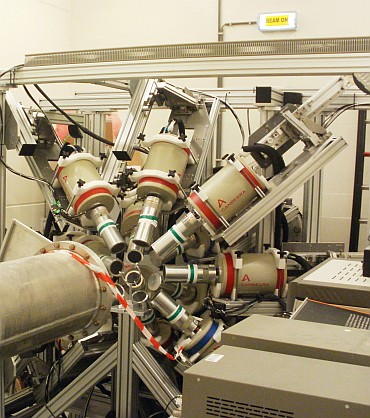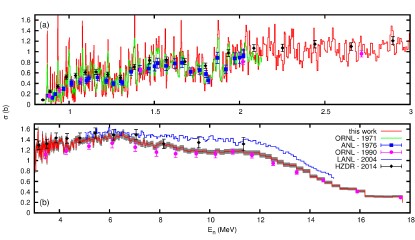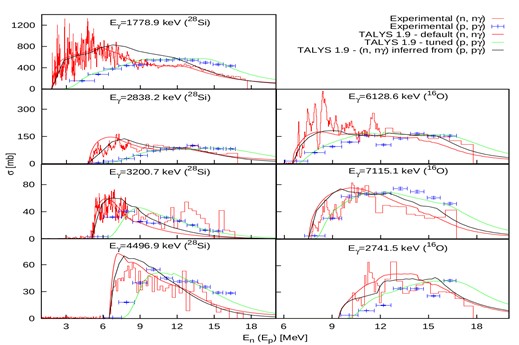

Neutron Induced Reactions Cross Section Measurements
Contact persons: Alexandru NEGRET, Catalin BORCEA, Adina OLACEL, Marian BOROMIZA, Andreea OPREA, Liviu STOICA
High precision cross section data are required for the development of the next generation of nuclear reactors, the so-called
Generation IV fission reactors. These are fast reactors, more secure than the current available reactors, producing a smaller
quantity of radioactive waste and, hence, offering a reliable solution to the energetic needs of humanity while minimizing the
quantity of CO2 emissions. A significant international effort is, therefore, made for the measurement of the neutron-induced reactions
on all the isotopes of interest for the development of such facilities.
We are involved in high-precision neutron inelastic cross section measurements performed at the neutron time-of-flight facility GELINA
operated by JRC-Geel in Belgium. The experimental setup consists of an array of 12 HPGe detectors operated together with a 235U
fission chamber used to integrate the neutron flux (see Figure 1). These are located at the end of a 100-m flight path, allowing cross section
measurements by combining the γ spectroscopy and the time-of-flight techniques.
The resulting data are unique in the world for their accuracy, neutron energy resolution and reliability. Figure 2 (taken from Ref. [3]) displays
the production cross section for the first γ transition in 56Fe compared to other previous measurements, emphasizing the quality of our results.
A second experimental facility we use to measure neutron-induced reaction cross section is n_TOF, the neutron time-of-flight facility of
CERN [7]. The neutron flux and the experimental setups installed there are complementary to the ones available at GELINA.
They are particularly fit for neutron capture and neutron-induced fission measurements. Being part of the very broad n_TOF collaboration,
we are primarily involved in two research topics: the effort of adapting the HPGe detectors to the particularly challenging experimental
environment available at n_TOF and neutron capture cross section measurements on several target nuclei. For more details please see the
references below or contact one of us.
References:
[1] A. Negret, L.C. Mihailescu, C. Borcea, Ph. Dessagne, K.H. Guber, M. Kerveno, A.J. Koning, A. Olacel, A.J.M. Plompen, C. Rouki, and G. Rudolf, Cross section measurements for neutron inelastic scattering and the (n, 2n) reaction on 206Pb, Phys. Rev. C91, 064618 (2015).
[2] A. Olacel, C. Borcea, P. Dessagne, M. Kerveno, A. Negret, and A. J. M. Plompen, Neutron inelastic cross-section measurements for 24Mg, Phys. Rev. C 90, 034603 (2014).
[3] A. Negret, C. Borcea, Ph. Dessagne, M. Kerveno, A. Olacel, A. J. M. Plompen, and M. Stanoiu, Cross-section measurements for the 56Fe(n,xnγ) reactions, Phys. Rev. C 90, 034602 (2014).
[4] A. Negret, C.Borcea, A.J.M.Plompen, Neutron inelastic scattering measurements for background assessment in neutrinoless double beta decay experiments, Phys. Rev. C88, 027601 (2013).
[5] M. Kerveno, J. C. Thiry, A. Bacquias, C. Borcea, P. Dessagne, J. C. Drohe, S. Goriely, S. Hilaire, E. Jericha, H. Karam, A. Negret, A. Pavlik, A.J.M. Plompen, P. Romain, C. Rouki, G. Rudolf, and M. Stanoiu, Measurement of 235U(n, nγ) and 235U(n, 2nγ) reaction cross sections, Phys. Rev. C87, 024609 (2013).
[6] D.Deleanu, C.Borcea, Ph.Dessagne, M.Kerveno, A.Negret, A.J.M.Plompen, J.C.Thiry, The gamma efficiency of the GAINS spectrometer, Nucl. Instrum. Meth. Phys. Res. A624, 130 (2010).
[7] https://cern.ch/ntof
